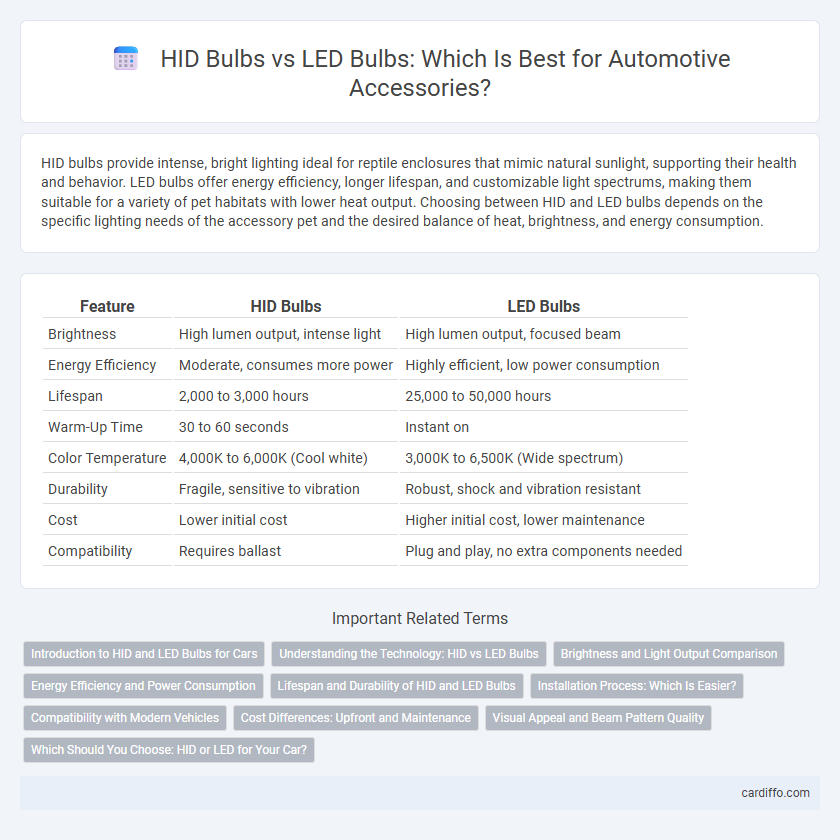HID bulbs provide intense, bright lighting ideal for reptile enclosures that mimic natural sunlight, supporting their health and behavior. LED bulbs offer energy efficiency, longer lifespan, and customizable light spectrums, making them suitable for a variety of pet habitats with lower heat output. Choosing between HID and LED bulbs depends on the specific lighting needs of the accessory pet and the desired balance of heat, brightness, and energy consumption.
Table of Comparison
| Feature | HID Bulbs | LED Bulbs |
|---|---|---|
| Brightness | High lumen output, intense light | High lumen output, focused beam |
| Energy Efficiency | Moderate, consumes more power | Highly efficient, low power consumption |
| Lifespan | 2,000 to 3,000 hours | 25,000 to 50,000 hours |
| Warm-Up Time | 30 to 60 seconds | Instant on |
| Color Temperature | 4,000K to 6,000K (Cool white) | 3,000K to 6,500K (Wide spectrum) |
| Durability | Fragile, sensitive to vibration | Robust, shock and vibration resistant |
| Cost | Lower initial cost | Higher initial cost, lower maintenance |
| Compatibility | Requires ballast | Plug and play, no extra components needed |
Introduction to HID and LED Bulbs for Cars
High-Intensity Discharge (HID) bulbs generate brighter, more intense light by producing an electric arc between two electrodes, offering superior visibility and longer range compared to traditional halogen bulbs. Light Emitting Diode (LED) bulbs use semiconductor technology to emit light efficiently with lower energy consumption, providing instant illumination and enhanced durability for automotive lighting. Both HID and LED bulbs improve nighttime driving safety but differ in power usage, lifespan, and installation requirements, making it crucial to select the right type based on vehicle compatibility and driving needs.
Understanding the Technology: HID vs LED Bulbs
HID (High-Intensity Discharge) bulbs generate light by creating an electrical arc between tungsten electrodes within a gas-filled tube, producing intense brightness ideal for wide-area illumination. LED (Light Emitting Diode) bulbs emit light through electroluminescence, offering higher energy efficiency, longer lifespan, and instant illumination without warm-up time. Understanding the contrasting technologies highlights HID's superior brightness for specific applications, while LED bulbs excel in durability and energy conservation.
Brightness and Light Output Comparison
HID bulbs produce significantly higher brightness levels with a luminous efficacy ranging from 75 to 95 lumens per watt, making them ideal for intense light output in automotive accessories. LED bulbs offer superior energy efficiency with a luminous efficacy between 80 to 100 lumens per watt, delivering bright, focused illumination while consuming less power. Compared to HID bulbs, LEDs achieve comparable or better light output with improved durability and quicker illumination response time.
Energy Efficiency and Power Consumption
HID bulbs consume significantly more power, typically ranging from 35 to 85 watts, whereas LED bulbs operate efficiently at 15 to 45 watts. LEDs convert a higher percentage of electricity into light, resulting in approximately 80% less energy usage compared to HID bulbs. The lower power consumption of LED bulbs translates to reduced energy costs and longer lifespan, making them a superior choice for energy-efficient lighting accessories.
Lifespan and Durability of HID and LED Bulbs
HID bulbs typically offer a lifespan of around 2,000 to 3,000 hours, while LED bulbs can last up to 25,000 to 50,000 hours, making LEDs significantly more durable for long-term use. The robust construction of LED bulbs allows them to withstand vibrations and shocks better than the fragile glass and arc tube components of HID bulbs. This enhanced durability and extended lifespan contribute to lower maintenance costs and greater reliability in automotive and accessory lighting applications.
Installation Process: Which Is Easier?
HID bulbs require a more complex installation process involving ballasts and igniters, making them less user-friendly for DIY enthusiasts. LED bulbs offer a straightforward plug-and-play installation, often compatible with existing wiring harnesses and sockets. This simplicity generally results in reduced labor time and fewer compatibility issues during setup.
Compatibility with Modern Vehicles
HID bulbs often require specific ballast and wiring, making them less compatible with modern vehicles designed for LED lighting systems. LED bulbs are more compatible with contemporary car electronics due to their lower power consumption and plug-and-play design features. Many manufacturers now equip vehicles with LED-compatible circuits, ensuring seamless integration and optimal performance.
Cost Differences: Upfront and Maintenance
HID bulbs typically have a lower upfront cost compared to LED bulbs but require more frequent replacements, leading to higher long-term maintenance expenses. LED bulbs, while initially more expensive, offer greater energy efficiency and durability, reducing overall costs over time. The total cost of ownership for LED bulbs is generally lower due to their longer lifespan and decreased need for replacement parts.
Visual Appeal and Beam Pattern Quality
HID bulbs produce a brighter, more intense light with a wider beam pattern, enhancing visual appeal through sharp contrast and clearer road illumination. LED bulbs offer a modern, crisp white light with consistent beam patterns that reduce glare and improve focus for better nighttime visibility. Both types contribute to vehicle aesthetics, but LEDs provide longer-lasting performance and more customizable lighting effects.
Which Should You Choose: HID or LED for Your Car?
HID bulbs offer intense brightness and a cool blue-white hue, ideal for enhanced nighttime visibility and long-range illumination in cars. LED bulbs provide energy efficiency, longer lifespan, and instant-on performance, making them a practical choice for daily driving and fuel efficiency. Choosing between HID and LED depends on your priority between brightness and efficiency, with LED bulbs increasingly favored for their durability and lower power consumption in automotive lighting.
HID bulbs vs LED bulbs Infographic

 cardiffo.com
cardiffo.com